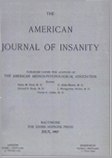THE QUESTION OF VERTEBRAL FRACTURES IN CONVULSIVE THERAPY AND IN EPILEPSY
Abstract
1. The considerable percentage of vertebral fractures in the middorsal region during metrazol convulsions can be reduced to a great extent by appropriate chemical or, better, simple mechanical means.
2. Reexamination of eight patients who had severe multiple fractures two years ago, showed no orthopedic or neurological signs of progressive pathology.
3. In electric shock therapy, even without precautions, these fractures are considerably less frequent. By applying an improved technique of extreme hyperextension, they can be avoided as was shown in 60 cases.
4. Seizures in epilepsy do not produce vertebral fractures in the middorsal region as demonstrated by a series of 42 epileptic patients. Fractures in other regions of the spine occur occasionally but they are of a different type and not comparable to the fractures in convulsive treatment.
5. Vertebral fractures in tetanus have the same localization, about the same frequency and multiplicity as those sustained in metrazol convulsive therapy done without precautions.
6. The varying frequency of vertebral fractures in the various convulsive conditions is explained by differences in the onset of the convulsion.
7. No contraindication against shock treatment can be seen in these fractures which can be largely avoided and which, if they do occur, have no clinical importance.
Access content
To read the fulltext, please use one of the options below to sign in or purchase access.- Personal login
- Institutional Login
- Sign in via OpenAthens
- Register for access
-
Please login/register if you wish to pair your device and check access availability.
Not a subscriber?
PsychiatryOnline subscription options offer access to the DSM-5 library, books, journals, CME, and patient resources. This all-in-one virtual library provides psychiatrists and mental health professionals with key resources for diagnosis, treatment, research, and professional development.
Need more help? PsychiatryOnline Customer Service may be reached by emailing [email protected] or by calling 800-368-5777 (in the U.S.) or 703-907-7322 (outside the U.S.).



